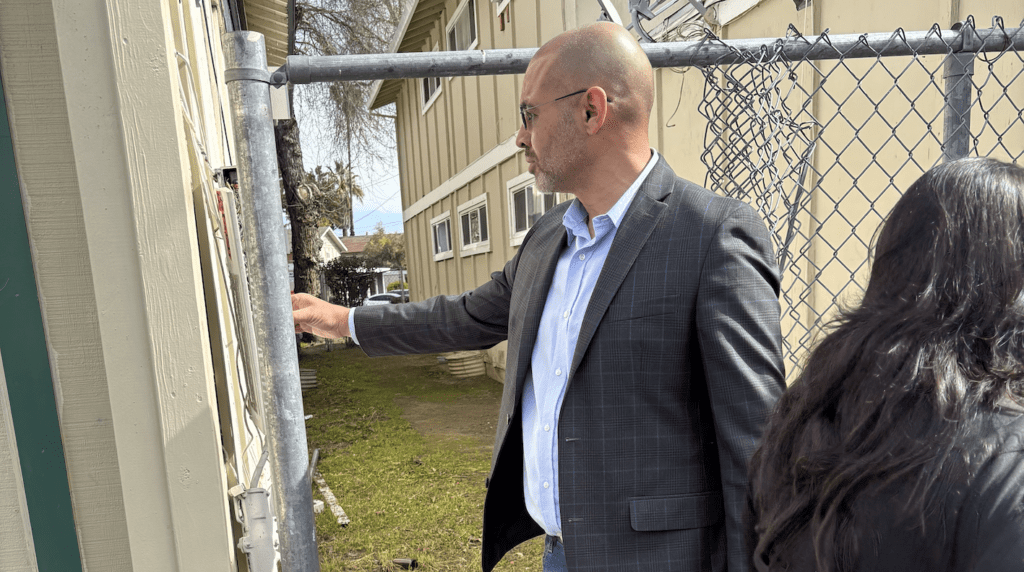South San Jose property owners want code enforcement to spend more time working with them on potential violations rather than punishing them.
District 10 Councilmember George Casey arranged for landlords and San Jose Planning, Building and Code Enforcement officials to tour a neighborhood on Feb. 28 between Blossom Hill Road and Almaden Expressway. Landlords want to work more proactively with the city before code enforcement slaps them with high fees due to blight. Code enforcement assigns a tier rating to buildings based on compliance and many of these properties are falling into the highest tier.
Property owners said the main issues causing these violations are graffiti, illegal dumping and homeless encampments encroaching on properties.
“It was important for me to get city officials, like those with code enforcement, out into the neighborhood to show them this place is an issue and it’s been overlooked,” Casey told San José Spotlight. “The city needs to do a better job of coming out and giving these folks an opportunity to (drop down) in the tier system if they demonstrate that they’ve modified or remediated any concerns or issues. But the problem is, it takes forever.”
He said it’s easy for landlords to land in tier 3 after violations, but it’s hard to drop down into a lower tier.
“There are some homes here that should be tier 1 based on the effort that landlords have put into it, and they’re still getting charged tier three fines and fees,” Casey said. “What if you bought a property that was in tier 3?”
Sadije Alaj, who has owned three properties near Via Monte Drive for 30 years, said she pays $1,000 in code fees for her property classified as a tier 3 — the most unfavorable tier in the system. Properties in this tier are inspected by city code enforcement every three years and pay the highest fees. But she only pays about $500 in code fees for both of her tier 2 properties, along with more time in between inspections.
“(Code enforcement) doesn’t really help us in lowering our bills when we’re the ones who are keeping the property up,” Alaj told San José Spotlight. “Then you have other homeowners who are not doing anything, just making their property an eyesore in the neighborhood.”

Rachel Roberts, city deputy director of code enforcement, said property owners can request an early tier review, but only if changes to their building are significant enough to be considered a remodel. She said they work closely with property owners to bring them up to code and are committed to improving that process. Ultimately, it’s the property owner’s responsibility, she said.
“Education and outreach are very important parts of code enforcement,” Roberts told San José Spotlight. “We spend a lot of time in our community teaching property owners about potential code violations and how to fix them. We welcome any request to come speak to groups that may be affected.”
Casey also wants to help the renters in the neighborhood, because not every landlord is addressing code violations on their property or working toward a lower tier.
“My goal is to ultimately connect with the tenants that are afraid to say anything,” he said. “It was important for me to get the city officials with code enforcement and the head of planning there to understand that this place is an issue and it’s been overlooked.”
Properties in lower tiers also generate an average of $9,265 in higher annual rent payments from tenants, according to data provided to the landlords by real estate broker Roberta Moore.
Alaj said the lack of city communication can make property owners feel like they’re working in the dark.
“It would be great if, by chance, they pass by your property and give you a call to say, ‘Hey I just noticed all this dumping,’ and I can take care of it right away,” she said. “They would rather keep us in a worse tier because the city wants money.”
 Roberts said inspectors are not playing a game of “gotcha” and property owners receive a checklist with notice of inspection, and are given time to make corrections before any violations are submitted for fines.
Roberts said inspectors are not playing a game of “gotcha” and property owners receive a checklist with notice of inspection, and are given time to make corrections before any violations are submitted for fines.
“We work with property owners making good faith effort and progress,” she said. “The primary focus in any inspection is substandard housing. Tenants have the right to safe housing and our inspections often help people out of dangerous conditions.”
Contact Vicente Vera at [email protected] or follow @VicenteJVera on X.



Leave a Reply
You must be logged in to post a comment.